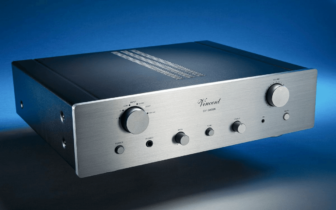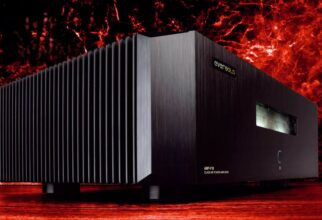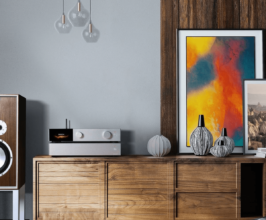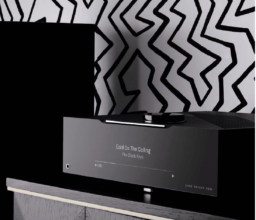McIntosh MI502 Review
The aesthetic is familiar, but this two-channel amp is cut from a different cloth than many of its stablemates. Mark Craven gets to grips with McIntosh’s custom install contender. Read our McIntosh MI502 Review.
AMERICAN MANUFACTURER MCINTOSH is known for its hi-fi hardware, including some premium, gorgeously styled tube amps, but as the launch of its MHT300 AV receiver (p8) shows, it keeps a toe in the home cinema arena. This, in turn, means it caters to the custom install market, which is where it aims its MI502 power amplifier.
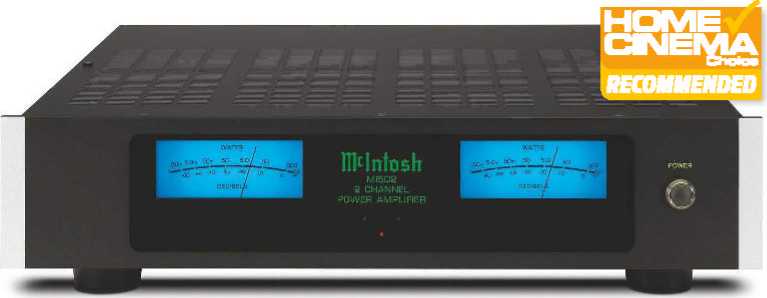
A stereo model, supplied with rack ears and taking a slim 2U form factor, the amp is suggested for use in multizone audio applications, powering the front pair in a separates-based AV setup, or for use with passive subwoofers. Its chassis is deep (53cm), although as it comes with pre-fitted feet there’s no reason it can’t be parked on an AV cabinet, providing it’s large enough.
You might want it on show, too, as the MI502 is just the latest good-looker to come out of McIntosh, complete with illuminated ‘Watt Meters’ to give you a visual real-time indication of its output. Rack it away in a boot-room and these will be wasted!
Raw power
This new ‘MI’ model, plus other slightly older designs in channel flavours from four to 12, are outliers in the McIntosh stable as they use Class D amplification rather than tube or solidstate Class A or A/B. Subsequently, the claimed power rating (considering the size of the hardware) is through the roof – 2x500W into 8ohm and 2x800W into 4ohm, enough to tackle any partnering speaker. By comparison, the most affordable stereo power amp in McIntosh’s lineup that doesn’t use Class D is the MC152, which sells for £ and is rated at 2x150W.
AV Info
CI-focused stereo Class D power amplifier
Joined by 4, 7, 8 and 12-channel Class D McIntosh designs
NAD M23; Monitor Audio IA750-2
While the view from the front is glam, the back panel is spartan, with just gold-plated binding posts, unbalanced stereo phono input, balanced XLR input and 12V in/out triggers for system integration. Fit and finish is as immaculate as you’d hope, though.
Inside, the balanced amp pairing is joined by a switchmode power supply stage, and various flavours of proprietary McIntosh tech, including Loudspeaker Guard clipping protection and Sentry Monitor, which cuts the amp’s output if a short circuit is detected. Two status LEDs on the front keep you abreast of operational status. Basically, if they don’t light up, everything is tickety-boo.
Fast times
Used either as a stereo amp for music, or as the main event in a multichannel system, the MI502 brings with it a tangible feeling of pure power and speed of delivery. Like other high-end Class D amps I’ve heard, it’s thrillingly responsive to the dynamics of a soundmix, guaranteeing that every jump scare or gunshot in a movie, or every kick drum in a rock song, hits lightning-fast. Its output doesn’t struggle either when the sound thickens and the crescendoes come. Largescale film moments swell from the speakers as they should.
Its performance is subjectively neutral too, without any feeling of additional warmth to the low- and mid-range. This might not be quite what a typical McIntosh buyer wants when it comes to music replay, but a focus on sheer clarity works well with film material dripping in detail. The Lego Movie (4K Blu-ray)
SPECIFICATIONS
POWER OUTPUT (CLAIMED): 2 x 500W (8ohm); 2 x 800W (4ohm) CONNECTIONS: 2 x balanced XLR inputs; 2 x RCA unbalanced inputs; 2 x speaker binding posts; 12V input; 12V output DIMENSIONS (INCL. RACK EARS): 483(w) x 110(h) x 533(d)mm WEIGHT: 10kg
FEATURES: Hypex Class D amplification; front-panel ‘Watt Meters’; channel status LEDs; Loudspeaker Guard and Sentry Monitor technology; input signal sensing
Blue-lit meters, green logo – yep, it’s a McIntosh has a chaotic soundmix packed with tiny details, some delicate, others dramatic, and they come through here with distinction.
Bass handling is great too, even if the MI502 gives ground to some rivals when it comes to ultimate low-end delivery, as it doesn’t seem keen to really ‘over-egg’ it. Paired with both B&W 705 S2 standmounts, and then some budget-but-boisterous Polk Monitor XT 70 floorstanders (HCC #330), it majors on extracting nuance and detail from bass effects, and keeping them fast and tight. The Lego Movie’s rapid-fire set-piece action is in safe hands.
It’s perhaps easier to get a real sense of the amp’s strengths with music material, and I found a simple two-box setup (running it off an Oppo UDP-203 disc player) yielded fine results. The MI502’s sonic signature works great with up-tempo tunes, whether that’s the poppy, fluid funk of Michael Jackson’s Bad or the razor-sharp rifling of Slayer’s South of Heaven, and it takes high-volume listening sessions in its stride. Its power output and transparency also pay dividends with quieter, more sparse material, as fleeting moments of detail and dynamism are conveyed.
Living the high life
It’s hard to shake the feeling that the MI502 represents McIntosh aiming at the CI market but not being able to shake its musical roots, as evidenced by the sultry styling and front-panel light show when a plain black box would suffice. There’s also the price tag to consider when comparing this amp to other install options. Its performance is superb, however, with a feeling of unburstable energy going hand-in-hand with a clear, revealing nature. Add it to your wishlist if you want a stereo power-pusher with a luxurious side



